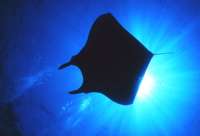500,000 Oysters Added to the Bay in Record Year
Volunteers with the Chesapeake Bay Foundation planted hundreds of thousands of baby oysters into a specially prepared habitat made of recycled chunks of concrete last week.

Nine manta rays were recently spotted for the first time in 20 years gliding through Basura, the internationally renowned dive site in the Philippines.
"We were observing a group of seahorses when the manta rays swooped by us," recalls Raymond Bersamin, an experienced diver who captured the sighting on video… The area of Mabini — about a three-hour drive south from the capital, Manila — was once known more for its accumulated refuse than marine life. "The spotting of the rays is a good indicator that the local ecological conditions are improving," said Marlyn Santiago, a site coordinator with World Wildlife Fund – Philippines.
In addition to manta rays, divers have also witnessed sea turtles and dolphins returning to the area.
Working to restore the area's once rich marine biodiversity, WWF, in coordination with the local government of Mabini, has implemented a coastal resource management programme for several years, including the creation of community-based marine law enforcement units. Currently, WWF is assisting the local municipality in developing water-use and zoning plans for Mabini's waters to further enhance coastal resource management in the area.
The manta ray, or giant manta (Manta birostris), is the largest of the rays, measuring up to 6.7m across its pectoral fins (or "wings") and weighing up to 1350kg. It ranges throughout the tropical seas of the world — typically around coral reefs — consuming plankton and other small organisms. Acting as a giant living filter, the manta ray helps restore water clarity, and by extension, photosynthesis — a process that is crucial to the continued health of coastal habitats and the marine food chain.
"It makes perfect sense to see mantas and other marine species here," added WWF-Philippines President Lory Tan, "And, conservation efforts are helping make sure that there is enough food for them along the coast of Mabini."
World Wildlife Fund
Be the first to comment